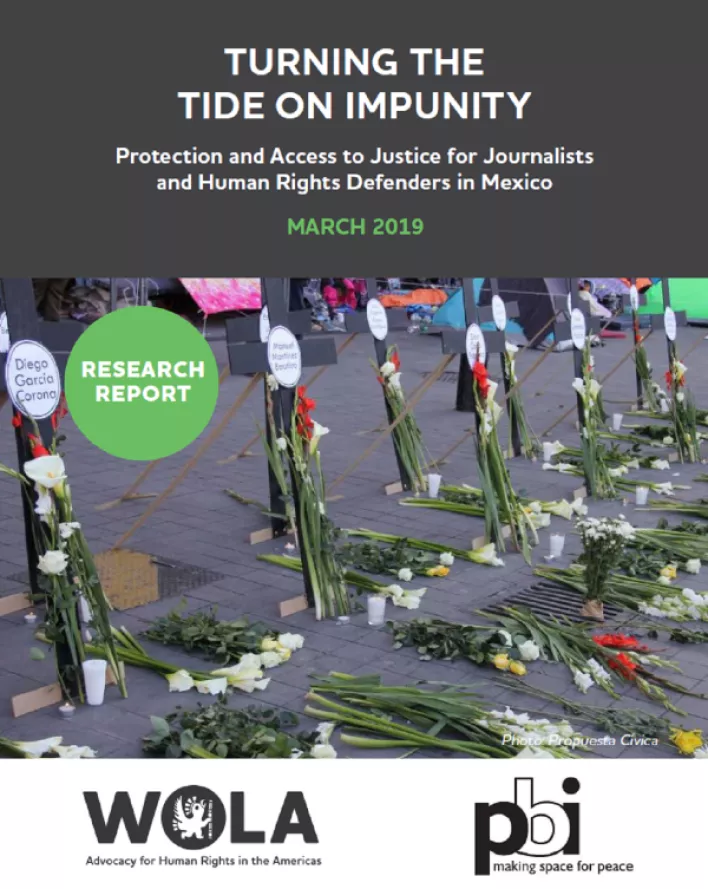Mexican President Andrés Manuel López Obrador took office after campaigning on a platform focused heavily on combating corruption and insecurity and bringing peace and reconciliation to the Mexican people.
A new report from the Washington Office on Latin America (WOLA and PBI) focuses on how the new government can approach an important aspect of this endeavor: creating a safer and more enabling environment for journalists and human rights defenders to carry out their important work.
Key Findings:
Image

- Protection measures provided through Mexico's Mechanism to Protect Human Rights Defenders and Journalists are often insufficient. The Mechanism has been unable to develop risk analysis protocols that effectively identify the different needs of female, rural, indigenous, and other particularly vulnerable journalists and defenders when it comes to receiving protections. Protection measures are often unreliable, are not adequately implemented, and do not take into account realities on the ground in different parts of the country. In some cases, they have been unable to provide sufficient protection: six Mechanism beneficiaries have been murdered since August 2017.
- The Mechanism suffers from a serious lack of adequate staffing and budget levels. There are only 35 Mechanism personnel overseeing the protection of 831 journalists and human rights defenders. Despite this context, Mexico's 2019 budget cut funds to the Ministry of the Interior’s Human Rights Unit—which finances the Mechanism's staff salaries—by over USD$610,500, meaning additional staff will likely not be hired in 2019. Moreover, while the Mechanism spent approximately $13.6 million on the implementation of protection measures in 2018, Mexico’s Congress only allocated up to $10.9 million for protection measures in the 2019 budget.
- The Mechanism has made progress in developing strategies that go beyond providing immediate protection to journalists and human rights defenders. Experiences in the state of Chihuahua could serve as a model for developing comprehensive prevention strategies that are more comprehensive and more attuned to local contexts. Since 2016, Mechanism officials have been working alongside Chihuahua's state government, national and international human rights bodies, and local civil society groups to develop a Contingency Plan focused on addressing the root causes of violence against journalists and human rights defenders in that state.
- Mexican authorities are frequently identified as the perpetrators behind crimes against journalists and human rights defenders. Public officials were determined to be the likely aggressors in 39 percent of cases the Mechanism has overseen. Similarly, “abuse of authority” was the second-most common crime reported by prosecutor’s offices that provided us with statistics on these crimes, pointing to how frequently public officials and security forces are involved in attacks. This helps to explain why many investigations into crimes against journalists and human rights defenders lack credibility and impartiality, particularly at the state level.
- The Mexican government’s failure to properly investigate and sanction crimes against journalists and human rights defenders has left these groups open to attack. Between 2012 and June 2018, only three percent of investigations opened by the state prosecutor’s offices analyzed by WOLA and PBI made it to the courts. Of the 1,077 cases investigated by the federal-level Special Prosecutor’s Office for Crimes against Freedom of Expression (FEADLE) during this period, less than 12 percent were taken to court. Only five FEADLE cases—less than one percent—resulted in convictions. Aside from its overall poor track record in prosecuting cases, FEADLE rarely takes advantage of its power to take investigations out of the hands of state prosecutor’s offices when state authorities are not handling the cases with due diligence.
- FEADLE’s capacity to fulfill its mandate has been severely limited by a lack of human and financial resources. The agency’s budget has been reduced by 54 percent since 2014, from over USD$2 million to around $942,000. The office only has 22 prosecutors and 15 investigative police officers on staff.
- Many prosecutor’s offices in Mexico do not maintain quality criminal statistics that could aid in criminal analysis and strengthen prosecutorial oversight. Without systematized databases with reliable statistics on crimes against journalists and human rights defenders, prosecutors are unable to draw patterns and connections between cases, or identify any common modus operandi used to target victims. Some offices do not track the status and results of their investigations, such as the outcome of cases that are tried in court. This makes it difficult for authorities to identify and rectify gaps in their investigative practices and processes, and makes clear that prosecutors in these offices are not being evaluated based on their performance.
- Some law enforcement institutions often devote valuable time and resources toward discrediting and criminalizing the work of journalists and human rights defenders, rather than guaranteeing their protection. There is a clear pattern of Mexican authorities misusing criminal legislation to criminalize activists and media workers. In Chihuahua state, for example, we found that over the period reviewed for this report, the number of cases in which authorities deemed journalists to be the alleged aggressors was more than double the number of cases opened into crimes committed against them.
- The U.S. government continues to provide significant funds to support the Protection Mechanism and to strengthen investigations into crimes against journalists and human rights defenders. In September 2017, the U.S. Agency for International Development (USAID) initiated a USD$7.1 million project called ProVoces. ProVoces consultants have provided trainings, mentorship, and technical assistance to the Mexican agencies charged with addressing violence against journalists and defenders and aims to strengthen coordination between prosecutor’s offices, federal and state-level protection mechanisms, and civil society organizations.
From PBI Mexico
Themes
